The Federal Reserve’s decision to lower rates twice, driven by signs of a slowing economy, was the biggest news in third-quarter 2019. Globally, trade tensions and an impending Brexit decision fueled uncertainty and market volatility continued. Despite this economic climate, the U.S. labor market experienced an increase in wages.
Every quarter, Morningstar’s quantitative research team reviews the most recent U.S. economic trends and evaluates the performance of individual asset classes. Then, we share our findings in the Morningstar Markets Observer, a publication that draws on quantitative analysts’ careful research and market insights.
Here’s some of what we detail in our latest quarterly market commentary. You can dive deeper into the report’s insights and key takeaways in our upcoming webinar.
Uncertainty about trade policy drove overall uncertainty to postcrisis highs
The Economic Policy Uncertainty Index taps into a number of sources, such as newspaper articles and economic forecasts, to measure the degree to which policy decisions (or indecisions) are affecting economic sentiment.
In the immediate postcrisis years, the headline uncertainty index was primarily driven by healthcare, regulation, and tax policy. But as shown on the chart below, trade policy uncertainty has spiked over the past year, driving the headline uncertainty index to its highest level since 2013.
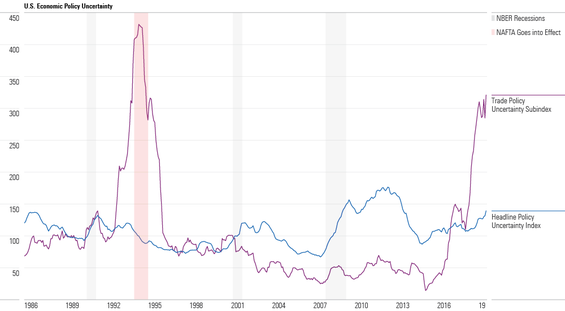
Source: Economic Policy Uncertainty. ©2019 Morningstar. All Rights Reserved.
Export and investment growth were net drags on the U.S. economy
As shown on the chart below, U.S. gross domestic product came in at about 2% annualized growth in second-quarter 2019. This was a slowdown from the first quarter, but still in line with longer-term trends. The headline print concealed that there have been notable developments in the underlying details.
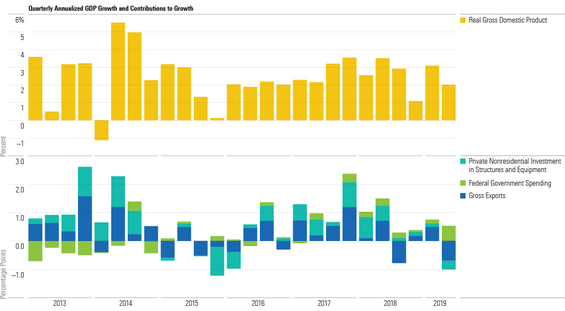
Source: U.S. Bureau of Economic Analysis. ©2019 Morningstar. All Rights Reserved.
The chart also shows that for the first time in nearly four years, both exports and private fixed-asset investments were net drags on growth. Federal spending partially offset this slump, accounting for 0.5 percentage points of positive growth in second-quarter 2019—its largest contribution since 2009.
Despite the global trade slowdown, there were indicators of a strengthening U.S. labor market
The past year has seen a fair amount of economic friction: Equities have whipsawed, interest rates have dropped, global trade has slowed, and policy uncertainty has risen.
Despite these trends, the U.S. labor market has shown remarkable resiliency. The chart below shows that job openings have increased, and firms have reported more difficulty filling positions. Meanwhile, involuntarily part-time work is down, as are initial jobless claims, and workers appear to be finding jobs easily. These trends show that if a recession is looming, it doesn’t appear to be affecting the labor market yet.
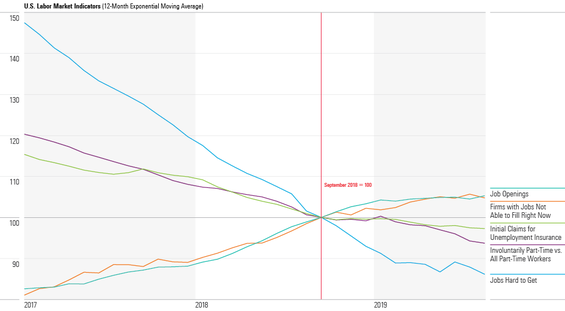
Source: The Conference Board, U.S. Department of Labor, U.S. Bureau of Labor Statistics, National Federation of Independent Business (NFIB). ©2019 Morningstar. All Rights Reserved.
U.S. repo rates climbed, and the Fed practiced open-market operations
The timing of the rate hikes in repo markets appeared to be related to the Treasury’s issuance of new debt, as well as seasonal factors that increased the demand for bank reserves. But the reduction of the Fed’s balance sheet over the prior 18 months was also key to this movement.
It remains to be seen whether the central bank will opt for a permanent expansion of the monetary base. But with inflation still below target, the risks will look more muted.
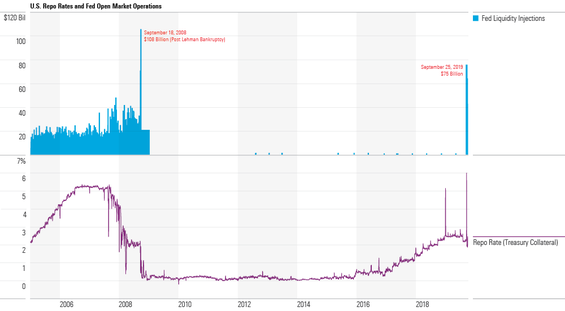
Source: Federal Reserve Bank of New York, Depository Trust & Clearing Corporation. ©2019 Morningstar. All Rights Reserved.
Cycles between growth and value continued
Similar to economic cycles, growth and value stocks have alternated leadership roles based on past performance, as shown here over the rolling three-year periods starting 1973.
While value beat growth during the 2000s, the trend reversed in the 2010s as growth outperformed value and continues to post large gains year-to-date 2019. Nonetheless, it’s challenging to predict whether the growth’s premium over value will persist, given the irregularity of the cycles.
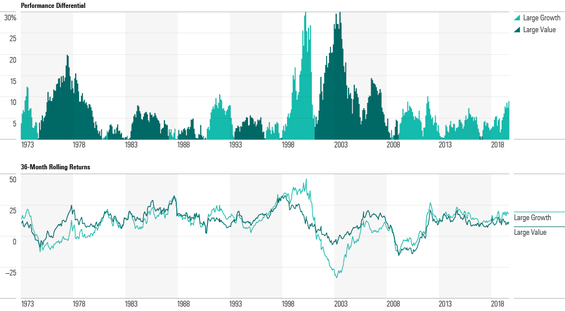
Source: Morningstar Direct. Large Growth — Morningstar US Large Growth Index. Large Value — Morningstar US Large Value Index. ©2019 Morningstar. All Rights Reserved.
To explore more insights on how your firm can manage through the latest market trends, sign up for our webinar.

